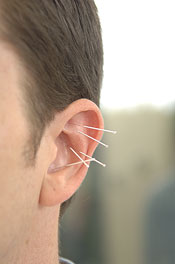Brain-Imaging Study Explores Analgesic Effect of Acupuncture
Although acupuncture has long been used to relieve pain, scientific understanding of how acupuncture might achieve an analgesic effect is incomplete. Previous research has linked acupuncture's effects to the neuronal networks and opioid (pain response) systems of the brain. In light of these findings, NCCAM-funded researchers at Massachusetts General Hospital recently used two imaging technologies—functional magnetic resonance imaging (fMRI) and positron emission tomography (PET)—to investigate how specific areas of the brain might be involved in acupuncture analgesia.
In the study, 12 people were exposed to heat pain and received either actual or sham acupuncture. Researchers used fMRI to examine the brain's pain responses before and after acupuncture. They used PET with a radioactive tracing substance to measure changes in opioid receptor binding during acupuncture.
The imaging results showed acupuncture-related changes in both of the brain's pain networks: the lateral network, which is associated with sensory aspects of pain perception, and the medial network, which is associated with affective aspects. However, the fMRI and PET results pointed to different areas in these networks, with one exception: both imaging technologies showed changes in the right medial orbitofrontal cortex—an indication that this area of the brain may be important in acupuncture analgesia.
The researchers note that their preliminary findings demonstrate that imaging studies using more than one imaging technique have potential for clarifying the neural mechanisms of acupuncture. They point out that similar studies with much larger samples might reveal other areas of the brain where fMRI and PET results converge.
Reference
- Dougherty DD, Kong J, Webb M, et al. 2008. A combined [11C]diprenorphine PET study and fMRI study of acupuncture analgesia. Behavioural Brain Research. Nov. 2008;193(1):63–68.
Additional Resource
- More information from NCCAM about acupuncture is available at nccam.nih.gov/health/acupuncture/.
Sign up for one of our email or RSS notifications to learn when new CAM-related information is available.

